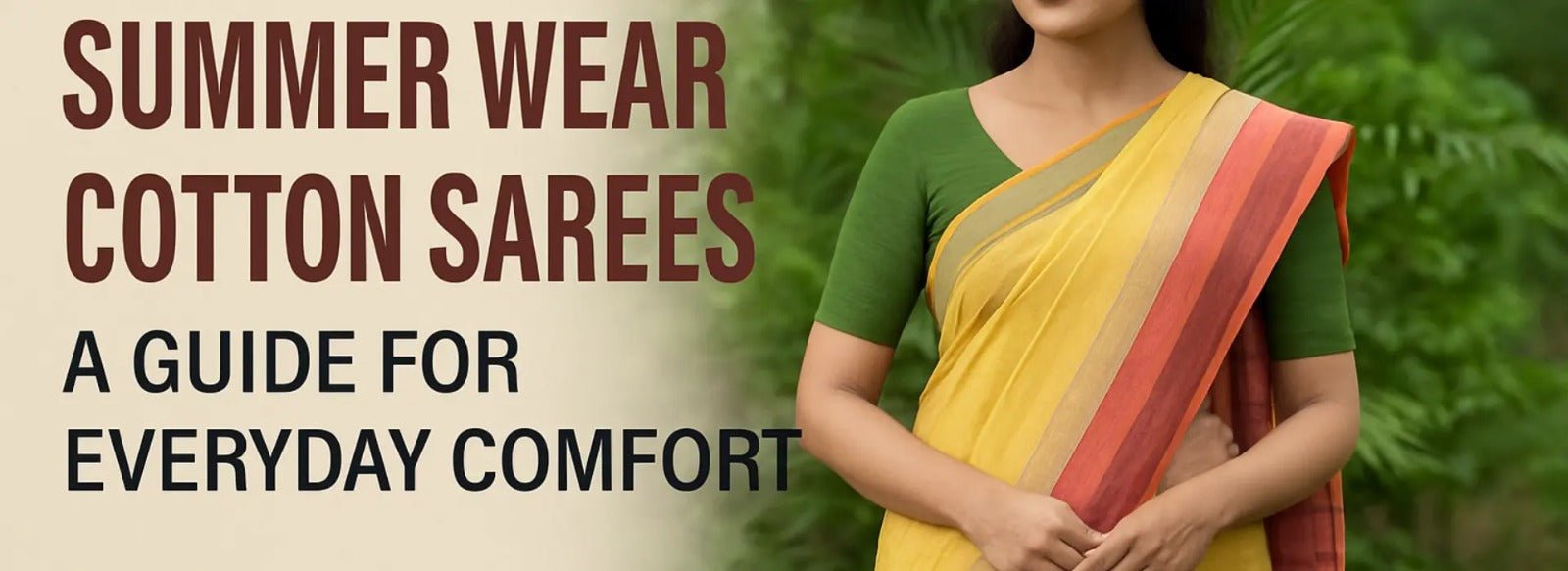The Indian summer demands clothing that allows breathability and ease of movement. Among daily options, summer wear cotton sarees continue to meet functional needs across regions. Cotton sarees' material, structure, and weaving method make them suitable for high temperatures and humidity.
Why Cotton Suits Summer
Cotton is a natural fibre that absorbs sweat and facilitates airflow. Unlike synthetic alternatives, cotton holds structure without trapping heat. This makes summer cotton sarees popular in rural and urban settings.
Handloom varieties enhance this function further. Loose weaving and minimal starching allow the fabric to adapt to the body's needs during the day. Women across India use cotton sarees not only for home wear but also for professional and ritual purposes.
Key Features of Summer Wear Cotton Sarees
-
Breathable Weave: Sarees with open weaves help manage airflow and reduce body heat.
-
Lightweight Structure: Less starch means less weight and is suitable for long hours of wear.
-
Minimal Print or Embroidery: Reduces fabric density, maintaining ventilation.
-
Natural Dyes: Often used to avoid chemical retention that can irritate in heat.
Popular Types of Cotton Sarees for Summer
1. Tant
Originating from Bengal, Tant sarees use a crisp weave and are often worn in daily routines. They offer a dry finish, and their porous structure helps absorb sweat.
2. Kota Doria
Produced in Rajasthan, these sarees are known for their khat (square) patterns. Their cotton blend structure allows air circulation, especially in dry climates.
3. Chanderi Cotton
Made in Madhya Pradesh, these sarees blend cotton with fine weaving techniques. They are suited for semi-formal wear without compromising airflow.
4. Chettinad Cotton
From Tamil Nadu, this type includes checks and bold stripes. The weave provides strength without retaining heat, which is crucial in southern summers.
How to Select the Right Summer Wear Cotton Sarees
When buying summer wear cotton sarees, consider the following:

-
Region of Origin: Local sarees often match climate needs. For example, Bengal cotton suits coastal humidity, while Rajasthan's Kota fits dry heat.
-
Weave Tightness: Loose weaves promote ventilation; dense weaves hold more heat.
-
Border Style: Thinner borders reduce weight. Avoid heavy zari in peak heat months.
-
Maintenance Needs: Some sarees require starch; others work better soft-washed. Consider wash cycles and fabric longevity.
Styling Tips for Cotton Sarees in Summer
-
Pair with sleeveless or half-sleeve cotton blouses.
-
Use cotton petticoats to avoid trapping heat.
-
Choose earthy or pastel tones that reflect sunlight.
-
Avoid layers; keep accessories to a minimum.
-
Use fabric sprays or light perfumes to refresh the saree throughout the day.
Everyday Use vs. Occasion Wear

While most cotton sarees for summer are designed for daily routines, some varieties, like Maheshwari or Chanderi, work in offices or small functions. The difference lies in detailing and colour schemes rather than fabric weight.
Care Guide
-
Wash in cold water with mild detergent.
-
Avoid machine drying; sun-dry in the shade to retain structure.
-
Light starching works well for formal settings.
-
Fold along existing lines to preserve the weave.
Frequently Asked Questions
Q1: Which cotton saree is best for humid climates?
Tant and Khadi cotton sarees perform well in humid regions due to their moisture-absorbing properties.
Q2: Can I wear cotton sarees for formal summer events?
Yes. Choose structured weaves like Maheshwari or Chanderi for formal events with minimal embroidery.
Q3: How do I know if a saree is pure cotton?
Check labels or verify with burn tests under safe conditions. Pure cotton chars and smells like burning paper.
Q4: Are printed cotton sarees suitable for summer?
Yes, if they use natural dyes and are loosely woven.
Q5: Do cotton sarees shrink after washing?
Preshrunk cotton may shrink slightly. Pre-washed options reduce this risk.
Summer wear cotton sarees continue to meet functional needs while aligning with local traditions and evolving daily routines. Choosing the right sarees for summer involves knowing fabric origin, weave density, and styling preferences. With options available across Indian regions, cotton sarees for summer remain a go-to solution for heat, tradition, and comfort.

